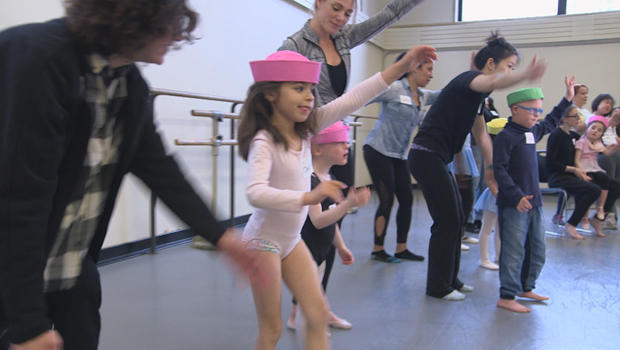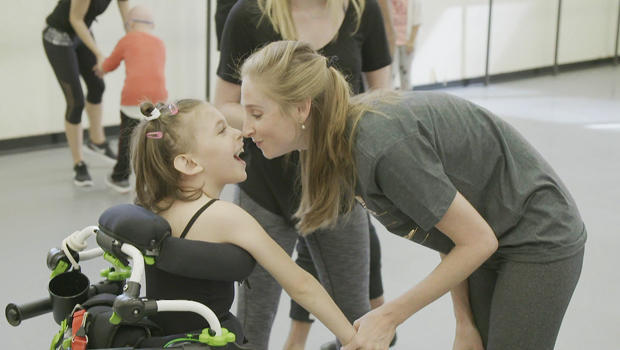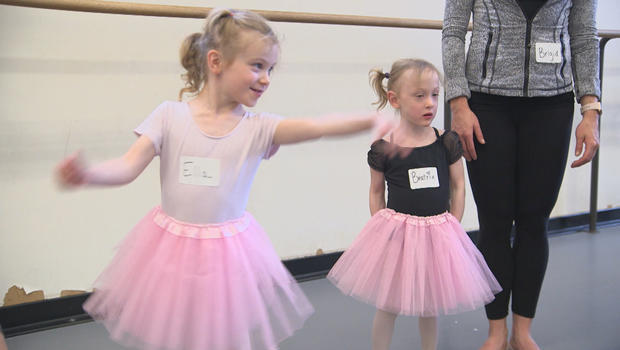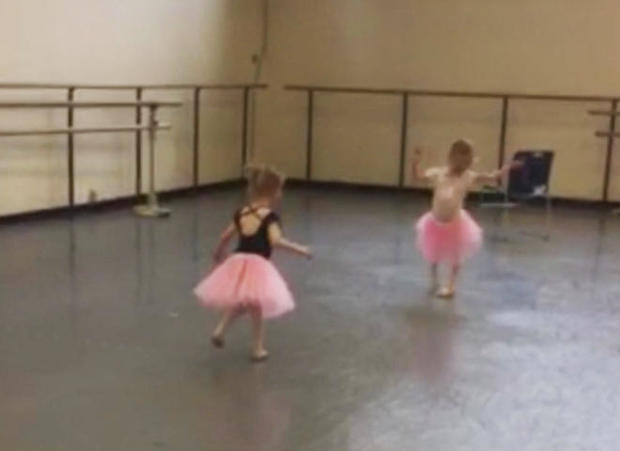Ballet is the stuff dreams are made of – the epitome of precision, grace and beauty. What little girl hasn’t dreamed of being up on that stage? Ten-year old Keren Rak-Mehler dreamed of being a ballerina, as she told us, speaking through her computer.
“I love to dance with my walker and learn new ballet moves,” she said.
Keren has quadriplegic cerebral palsy.
“It was way too intimidating to every place that I asked about the dance programs – a, the wheelchair, b, the fact that she’s non-verbal,” said her mother, Iris Mehler. “They couldn’t quite handle the situation.”
Then Iris found a place that could handle the situation, where kids with disabilities of any kind can wear tutus and top hats, and dance.
For the last four years the New York City Ballet has offered a series of workshops for disabled youngsters. Siblings are welcome, too.
CBS News
“Five minutes before the class, it’s total carnage, but there’s actually a method to the madness that’s going on,” said Dr. Joseph Dutkowsky, who is a specialist in cerebral palsy.
The program came about when a mother of a child with cerebral palsy wrote the New York City Ballet and asked if they’d ever done workshops for children with disabilities. They hadn’t.
The Ballet’s Meghan Gentile reached out to Dr. Dutkowsky to help design such a program.
The key, said Gentile, was “not making this a therapy session, just really giving them the experience to move in a studio with live music, with other dancers.”
Doctor’s orders: no wheelchairs, and no braces.
“A mother came up after our first class and said, ‘I looked over and saw my daughter’s wheelchair, and she wasn’t in it!'” said Dr. Dutkowsky.
“Makes me cry,” said correspondent Lesley Stahl.
“Makes me smile!”
The teachers are New York City Ballet dancers, like soloist Ashley Laracey. “I left my first workshop here feeling that I had to be part of these children’s lives,” she said.
Iris Mehler told Stahl, “You see the two extremes: the people with the most profound control over their movements, the New York City Ballet dancers coming here to teach our children that has zero control, sometimes, over the muscles of their body. There’s something really touching about that. It’s really touching. I’m grateful.”
CBS News
Laracey said, “I broke my fifth metatarsal on stage in a performance of ‘Firebird.’ And I remember asking, ‘Can I still participate even though I have my boot on and I can barely walk?’ And we all talked about it and said it would be a great thing for the children to see that even I have disabilities at times, and we can all still dance and do the best we can.”
Russell Janzen, one of the Ballet’s principal dancers, said, “We always create combinations that are really fun. These workshops are really about the joy that dance brings.”
Beatrix Quidort was a micro-preemie — one pound, five ounces at birth. At three, Beatrix was diagnosed with cerebral palsy, which affects the muscles primarily.
Cognitively, say her parents, Theron and Caroline, she is “fantastic … at or above average.”
“Our mission is just to make her feel strong and independent, and capable enough that it won’t be a big deal for her,” Theron said.
They live in Binghamton, New York, a three-and-a-half hour drive from Manhattan.
“That’s a lot of driving,” said Stahl.
“It is,” said Caroline. “It’s nice to be able to speak to another parent and say, ‘Oh your kid’s doing a nice job,’ or ‘Look at how cute they are,’ and to connect with other people and other kids.’
One of those other kids is five-year-old Ella Parsons, also with cerebral palsy, also from Binghamton. Ella’s mom Alyson, and her parents, Joe and Janice, all made the long drive to watch Ella dance.
CBS News
Stahl asked her mom, Alyson, “Does she do you think have the sense that she’s a little different from other kids?”
“Yes. I think she does. I’m pretty sure she does,” she replied. “She loves dancing.”
“And does she feel when she there that she is a ballerina?”
“I believe so, yeah!”
Joe said,” Whatever her feelings are inside of her, it’s comin’ out when she spins around and stuff like that.”
Stahl asked, “Tell me the truth: Did it ever bring you to tears?”
“Oh, yeah, it does, Joe and I both,” said Janice. “We’re so proud to see her out there.”
Stahl said, “It’s almost as if there’s karma here. ‘Cause there’s another couple from the same town you’re in, and those little girls are about the same age. Somebody’s giving you a little gift here.”
“Yes, I’m hoping we can foster that,” Alyson said.
While Stahl was interviewing their parents, the two little girls from Binghamton had already found each other and were dancing together in the next room.
CBS News
“If you have tutus and you’re playing music, they going to dance,” said Dr. Dutkowsky.
“Just like any other kid!” added Gentile.
Dr. Dutkowsky sat with one child in his lap, doing the movements for him. “Halfway through that lesson, the mother turned to me and said, ‘He looks so happy, he’s having so much fun. Would you mind if I go and sit down?’ And I said, ‘That would be wonderful.’ Because that was part of the goal, is that parents can sit there and watch, just like at a Little League game.”
On the final Saturday of the workshops, the children joined hundreds of other children, to watch the New York City Ballet dancers perform … and to dream.
Stahl said, “Watching your daughter and all the other kids, it’s just overwhelming. And you almost can’t explain what that emotion is, ‘Cause it’s not sad.”
“No,” said Caroline Quidort. “I think it’s joy.”
For more info:
Story produced by Mary Lou Teel.



